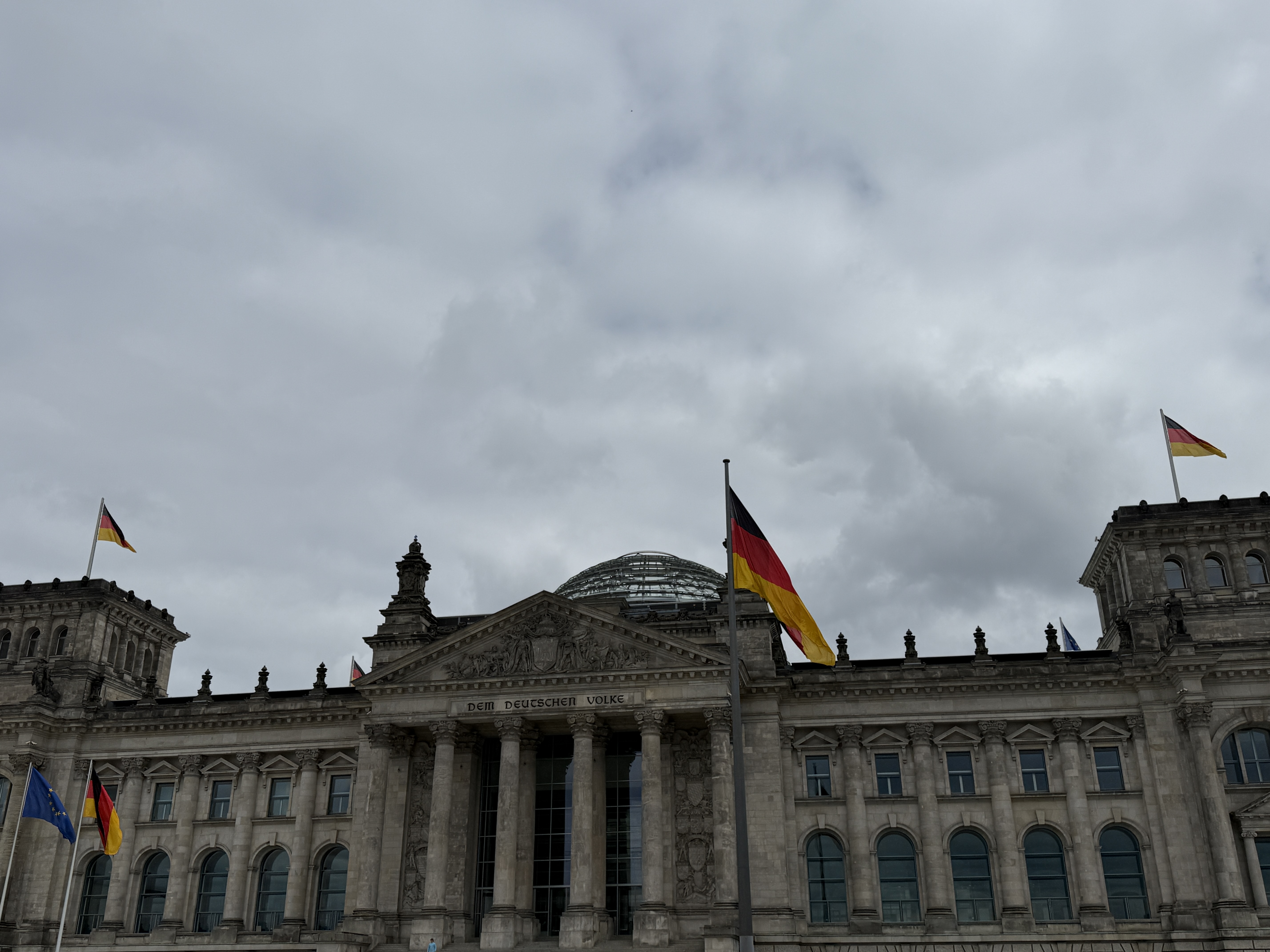Last Updated July 2025
John has always shown an interest in WWII. Whether it’s reading books, playing video games, or watching films based on the war, he has a real desire to know all about it. I don’t share his passion, so when he had the opportunity to go on a boys’ weekend away, Berlin was the perfect choice for him, the city is steeped in WWII history.
With a visit to the TV Tower planned, a few drinks in the Berlin Ice Bar and a trip to Olympiastadion they had to fit in a WWII walking tour in Berlin. After doing his research, it was clear he would be immersing himself in as much history as possible. It is an absolute must for history buffs or anyone seeking to understand the profound impact of World War II. The immersive experience takes visitors through the historic heart of the city, exploring key sites that played a pivotal role in the war and its aftermath.
Although I wasn’t there, I genuinely enjoyed hearing all about his walking tour and if WWII history interests you, this roundup of the must-see stops on a Berlin WWII walking tour is essential reading before you go.
Why Take a WWII Walking Tour in Berlin?
Berlin's war history is fascinating, complex, and at times, harrowing. As the epicentre of the Nazi regime, many of WWII’s key events unfolded here. A walking tour offers an intimate, first-hand look at significant WWII sites — far more immersive than a traditional museum visit.
The tour guide was excellent, knowledgeable, engaging, and clearly passionate about Berlin’s history. Although not originally from Germany, he had lived in the city for over 10 years and spoke with emotion and empathy about Berlin’s dark past. His insight made the tour even more profound.
WWII Sites in Berlin to Visit on a Walking Tour
Brandenburg Gate - A Symbol of Division and Reunification
The Brandenburg Gate is one of Berlin's most iconic landmarks. It once symbolised the division of East and West Berlin during the Cold War, but during WWII, it played a different role. Here, Nazi parades took place, and its significance evolved through the years. During their walking tour, they learnt how the Brandenburg Gate went from a symbol of Nazi power to one of the most important symbols of unity in post-war Berlin. The gate is much bigger than they expected it to be, and with straight roads running up to it for miles you can almost see the Nazi soldiers marching up the road and through the gate.
The Reichstag Building - A Landmark of German Politics and WWII History
The Reichstag building is another essential stop on the WWII walking tour. It was severely damaged by a fire in 1933, an event that Hitler used to justify his rise to power. The building was also central to the post-war history of Germany. On their tour, they heard stories of how the building was rebuilt after WWII and how it became the seat of the German parliament in the reunified Germany. The Reichstag looks to be a building full of history and things to see. You can book to visit the building and the dome on top which is used as a viewing platform - but you will need to book months in advance and provide details such as passport as you are entering a real government building.
Memorial to the Murdered Jews of Europe (Holocaust Memorial)
A sobering but essential stop, the Holocaust Memorial consists of 2,711 concrete slabs arranged in a grid pattern. This monument serves as a remembrance to the Jewish victims of the Holocaust. The memorial offers an opportunity for reflection, and their guide shared insights into the historical significance of this site, discussing the atrocities of the Holocaust and its lasting impact on the Jewish community and Germany. This was the most powerful stop on the tour. They were left to wander through the large area, making their own interpretation of what the slabs mean is certainly an experience. Our tour guide told us that the memorial was going to placed outside the city boundary, however the Berliners wanted it right in the centre. This is a reminder of the mistakes of the past, and to honour those killed by the Nazi war machine.
The Berlin Wall Memorial - Dividing a City, Uniting a Nation
While the Berlin Wall isn’t directly related to WWII, it is a critical aspect of Berlin’s 20th-century history. On their WWII walking tour, their guide explained how WWII led to the division of Germany and Berlin, culminating in the construction of the Berlin Wall in 1961. The Berlin Wall Memorial offers a stark reminder of the city's division and the toll it took on families and communities. The remains of the wall itself can be seen in several places throughout Berlin. Interestingly there is a trace of the wall everywhere the wall stood. Even on main busy roads, there is a clear line where the wall once stood and even steel rods that have been cut down to road level are clearly visible.
The Topography of Terror - Nazi History Exhibition
Another essential stop is the Topography of Terror, located on the site of the former SS headquarters. This open-air museum documents the rise of the Nazis and their atrocities during WWII. The exhibition includes photographs, documents, and videos that provide in-depth information about the Gestapo and the SS, making it an indispensable stop for anyone interested in the dark chapters of Berlin’s history.
The Former Nazi Bunker - Where Hitler Lived and Died
A short walk from the Brandenburg Gate, they visited the site of the Nazi bunker where Adolf Hitler spent his final days. Although the bunker itself was destroyed after WWII, the location is still marked, and it’s an important place to understand the final days of the Nazi regime. You can tell that although the German people want to be reminded of the horrors, in a way preventing anything like what happened ever happening again, there is also a desire to forget. The bunker although marked, is now a car park with very little to see. A sign of the Berliners wanting to move on with life.
What to Expect on Your WWII Walking Tour in Berlin
Most WWII walking tours last between 3 to 4 hours, providing an in-depth exploration of Berlin’s WWII history. The tour guides are usually local historians or experts in WWII, offering insights that go beyond the usual tourist explanations. Expect to walk through some of the city’s most historical neighbourhoods, gaining a deeper understanding of how WWII shaped Berlin and Germany’s post-war recovery.
Tips for Your WWII Walking Tour in Berlin
- Wear comfortable shoes. You’ll be walking for a few hours, so make sure to wear shoes that are comfortable and suitable for walking.
- Book in advance. WWII walking tours are popular, especially in the peak tourist seasons, so it’s advisable to book your tour in advance.
- Bring a camera. While some sites are somber, there are still plenty of beautiful and iconic sights in Berlin that you’ll want to capture on camera.
- Be prepared for a reflective experience. WWII history is heavy, and the tour might be emotionally intense at times. Take your time to reflect on the significance of each site.
What Did They Think Of The Tour?
Their WWII walking tour in Berlin was an educational and poignant experience that provided them with a deeper understanding of the city’s role in one of the most significant periods of modern history. From the Brandenburg Gate to the Nazi Bunker, the tour offered insights into Berlin’s transformation through the lens of WWII. Whether you’re a history enthusiast or simply looking to learn more about the past, a WWII walking tour should be at the top of your list when visiting Berlin.
You can view a range of Berlin Walking tours online and if you do visit then please do let us know as we'd love to hear about it.
- If you enjoyed this post leave us a comment.
- If you have visited any of the attractions mentioned in this post share photos with us on our socials.
- If this post has helped you in anyway you can Buy Us A Virtual Coffee to say thanks.
- If you would like to work with us please visit on Work With Us page for more details
Michelle


















